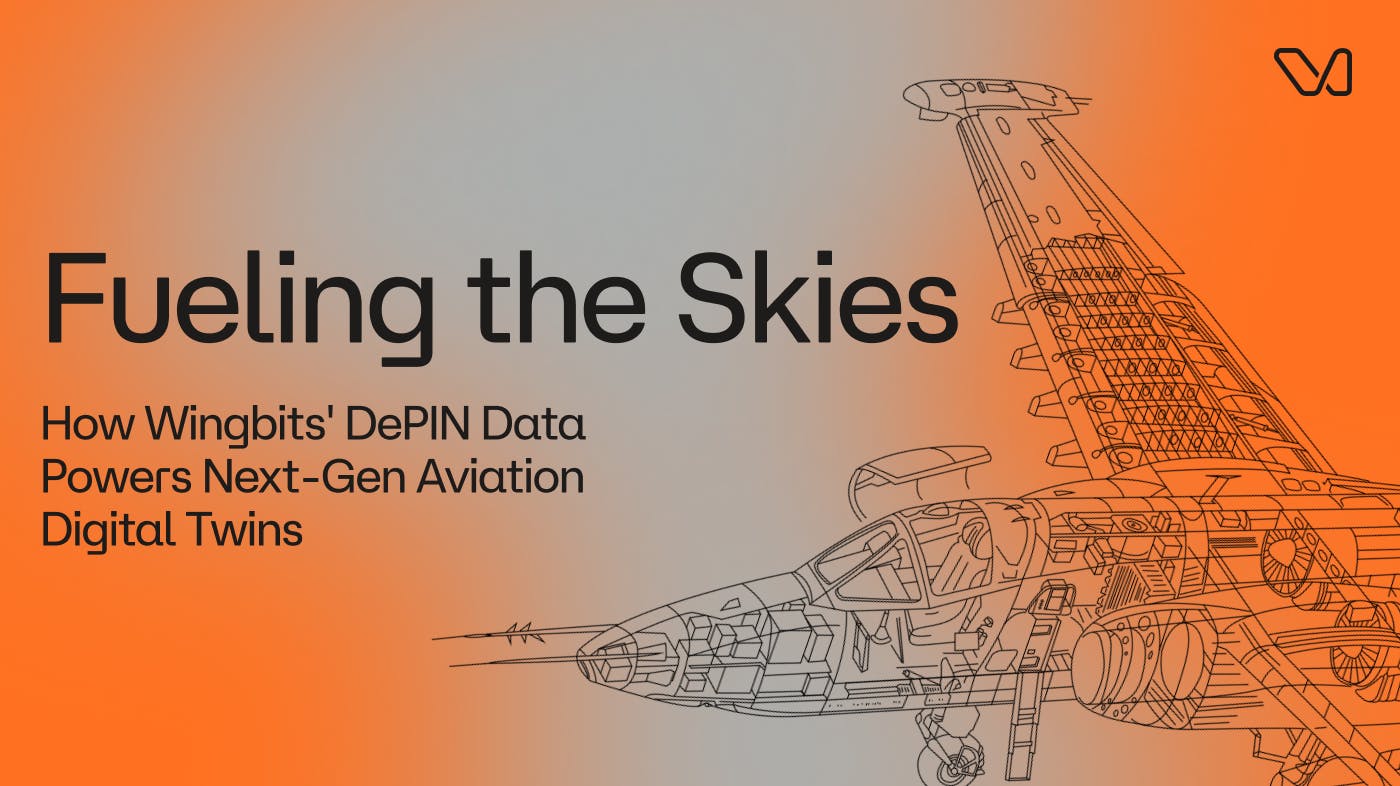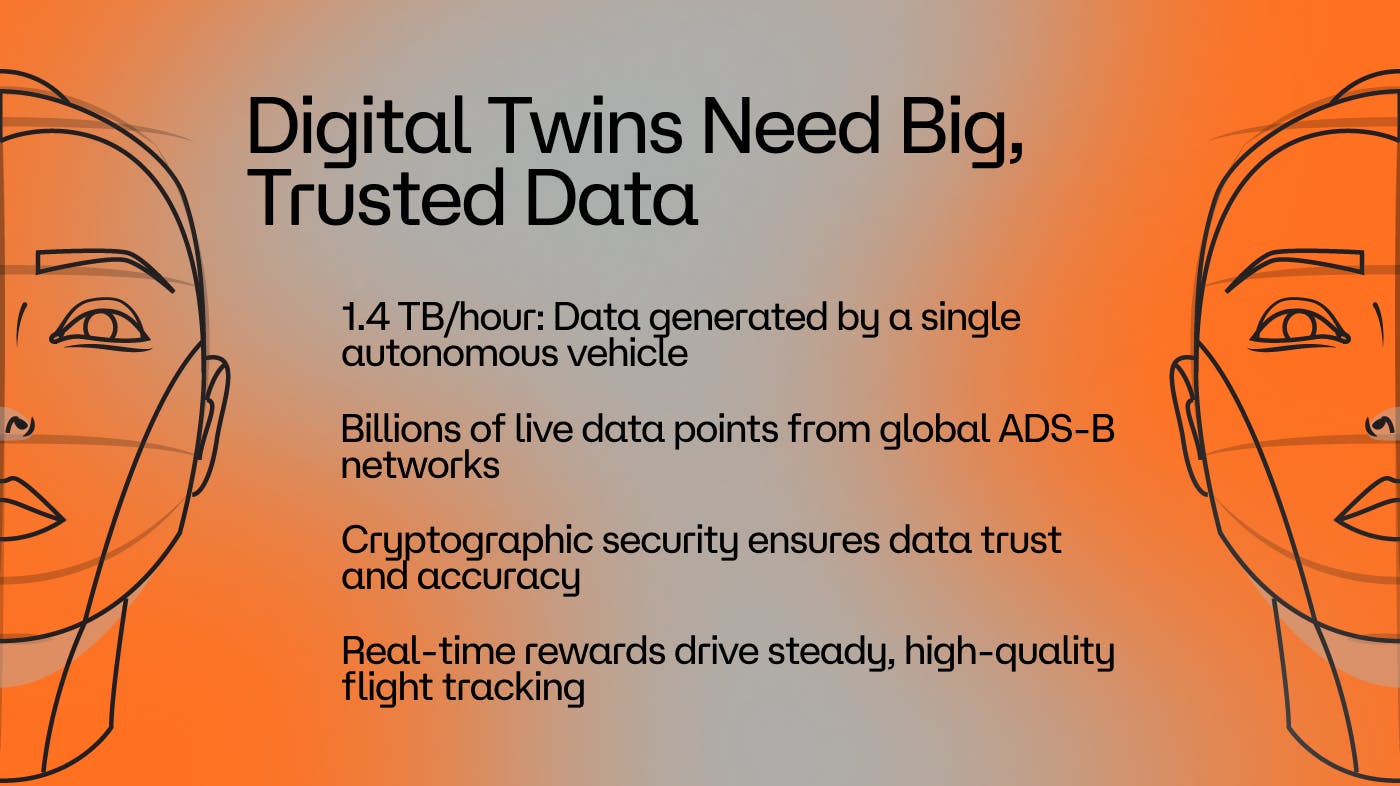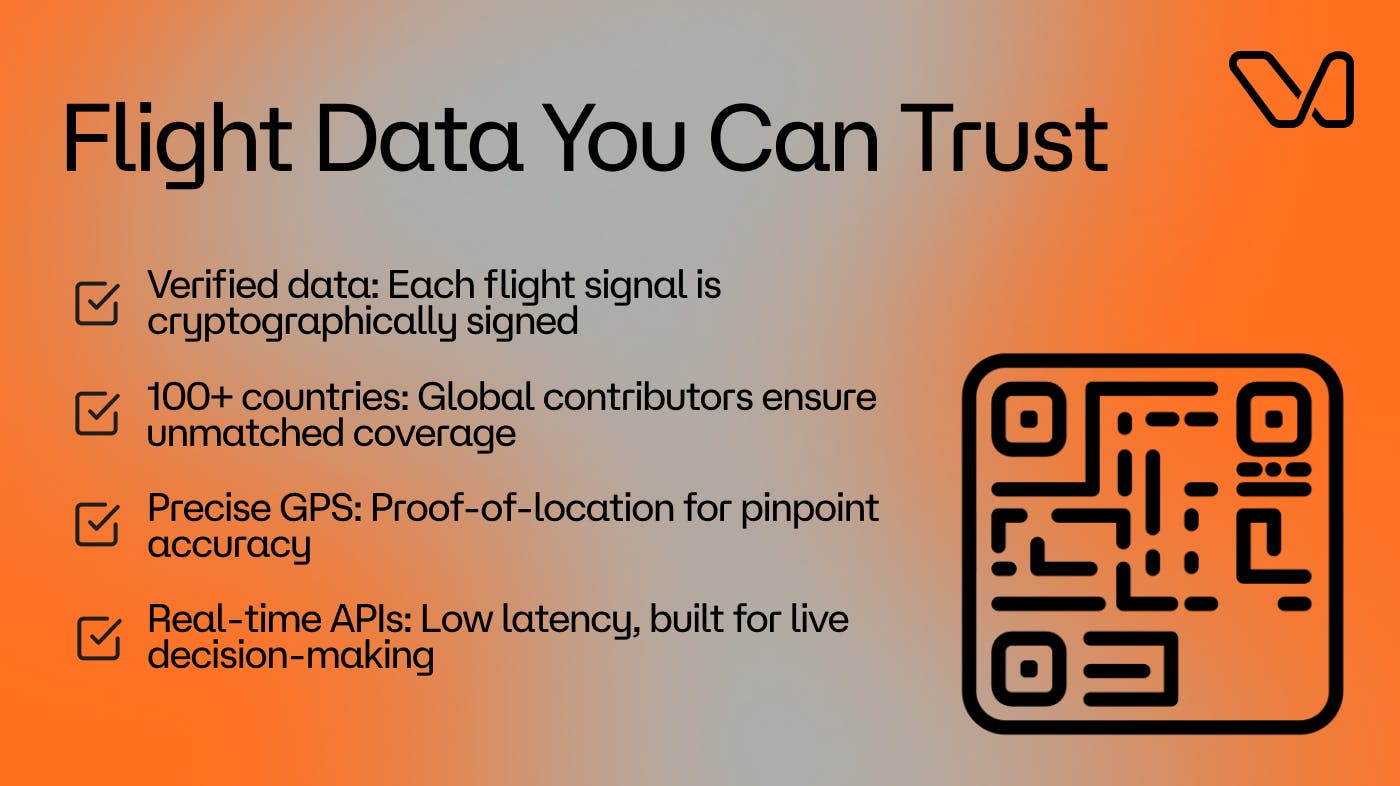Fueling the Skies: How Wingbits' DePIN Data Powers Next-Gen Aviation Digital Twins
Wingbits
June 24, ‘25

What Are Aviation Digital Twins?
Ever wondered how airports or major cities create live, 3D models of the sky? That’s the power behind aviation digital twins. These are dynamic, spatially-accurate virtual replicas of aircraft, airspace, and other aviation assets. But they’re not just fancy models. Today, digital twins are rapidly becoming advantageous for air traffic management, urban air mobility, aerospace manufacturing, and more.
Think of them as living digital ecosystems that reflect real-world flight operations, airspace conditions, and even drone activity, constantly updated by streams of real-time data. In the era of decentralized networks and big data, the aviation industry is moving from “flying higher” to “flying smarter,” where every decision is driven by live, actionable information.
Why Accurate, Real-Time Data Is Vital
Building a digital twin of the skies isn’t just a technical challenge, it’s a data challenge. Imagine tracking every altitude change, heading, or shift in GPS position for thousands of aircraft and drones. Autonomous vehicles alone can generate up to 1.4 terabytes of data per hour. That’s the scale needed to power accurate simulations, advanced analytics, and real-time decision support in aviation digital twins.
But it’s not only about the sheer volume. Data must be cryptographically secure, granular, and globally comprehensive, otherwise, the digital twin is just a rough sketch, not a true reflection of real-world conditions. For B2B leaders in air traffic management, aerospace manufacturing, or drone operations, this distinction means the difference between operational clarity and costly guesswork.
Incentives to contributors: A reliable incentive system assures steady, high-quality data flows.
ADS-B network: Modern networks aggregate billions of live data points, critical for digital twins.
Earn rewards tracking flights: Real-time compensation attracts and retains global contributors.

Challenges with Traditional Data Sources
Now, consider this: the flight tracking industry largely relies on data from unpaid volunteers. While volunteerism sounds noble, this legacy model is nearing its limits:
Data quality varies wildly due to inconsistent hardware and contributor commitment
Slow, unreliable API responses and infrequent updates disrupt analytics
Spotty global coverage leaves blind spots, especially outside major metropolitan areas
Susceptibility to hardware originated data manipulation threatens data integrity
Even established systems often struggle to scale coverage and ensure trust. For organizations managing urban air mobility, drone fleets, or advanced aerospace projects, these flaws aren’t minor, they can directly impact safety, compliance, and efficiency.
It’s clear: the aviation sector needs a new approach, one that rewards contributors, secures data, and delivers true global coverage.
How the Wingbits DePIN Flight Tracking Network Delivers Unmatched Data
Consider a different approach. What if your airspace simulation was powered by data you could verify down to the millimeter? Wingbits is pioneering this change as the first reward-based, decentralized DePIN flight tracking network. This isn’t just incremental improvement; it’s a significant shift in how aviation data is gathered, validated, and shared.
Thousands of global contributors, motivated by real-time flight tracking rewards in $WINGS tokens, stream live, cryptographically-secured flight data. Imagine if every data point in your digital twin was verifiably authentic.
Cryptographic Security and Proof-of-Location
At the heart of the Wingbits network is cryptographic security. Flight data is not just collected; it’s signed and verified at the source, leveraging proof-of-location technology with hyper-accurate GPS positioning. For B2B teams concerned with compliance, safety, and simulation precision, these safeguards provide a real operational advantage.
Secure ADS-B data: Each signal is cryptographically validated at the edge, minimizing risks of spoofing.
Global coverage: Contributors in 100+ countries enable best-in-class data reach.
Low-latency APIs: Data is delivered at speeds fit for real-time analytics and airspace management.
With these layers of security, organizations can trust that their analytics, simulations, and operational decisions are based on high quality data.
Rewarding Data Contributors for Network Growth
A key innovation: Wingbits actively values its contributors. The transparent $WINGS token system incentivizes participation, so the network expands where it’s truly needed, avoiding the pitfalls of the old volunteer model. This creates balanced global coverage, high uptime, and consistent data quality.
Real-time crypto rewards for uptime and accuracy
Community-driven global expansion
Dynamic balancing of supply and demand to prevent oversupply
Wingbits secured paying clients and a waitlist for its data services before mainnet, a testament to real-world demand for secure, accurate flight data.
Of course, decentralization requires constant optimization. The network must continuously tune reward structures and hardware placement to ensure resilience and efficiency as demand evolves.

Powering Next-Gen Digital Twins: Real-World B2B Applications
Picture a world where every flight, from commercial travel to emergency rescue, is tracked in real time, with no blind spots. For urban air mobility and UAV operators, Wingbits provides this foundation, enabling safe, compliant, and efficient operations at scale.
As the drone sector grows (already a multi-billion-dollar market), secure, accurate ADS-B data becomes non-negotiable. Wingbits is positioning itself to capture this growth by supplying data streams designed for complex, vertical operations in urban environments.
Flight data tailored for multi-layered city airspace
Live tracking for regulatory compliance and risk mitigation
A hypothetical example: An emergency medical UAV operator leverages Wingbits APIs for real-time flight corridors, avoiding restricted airspace and expediting life-saving deliveries.
Air Traffic Management & Aerospace Manufacturing: Data-Driven Benefits
For air traffic management (ATM) and aerospace manufacturers, dependable real-time data is vital. Digital twins powered by Wingbits’ secure ADS-B data API optimize everything from flight path deconfliction to predictive maintenance and logistics planning.
Enterprise platforms, like Microsoft Azure Digital Twins, already depend on high-velocity IoT data. Wingbits takes this further with cryptographic authentication and worldwide reach, unlocking use cases previously out of reach for legacy providers.
Accelerated incident response and risk analysis
Automated, data-driven maintenance scheduling
Streamlined regulatory reporting and compliance
B2B clients can evaluate DePIN networks like Wingbits by considering API reliability, data validation methods, and real-world use cases. Transparent documentation and open standards also support smoother integrations.
ML/AI, Simulation, and Big Data Analytics: Unlocking New Possibilities
Machine learning and AI thrive on trustworthy, high-resolution data. With Wingbits, analytics platforms and simulation tools can finally ingest live aviation data that’s cryptographically verified and globally available.
Improved anomaly detection and scenario modeling
Reduced false positives from spoofed or missing data
Faster iteration for AI-driven operational intelligence
Integrating these advanced data streams into legacy systems can be challenging. Phased adoption, robust APIs, and cross-functional collaboration are key, yet the payoff is a live, tamper-proof map of the skies, accessible on demand.
For instance, a machine learning team at an aerospace manufacturer used Wingbits data to train algorithms for predictive maintenance, leading to earlier fault detection and millions in cost savings.
Addressing Challenges: Security, Interoperability, and Scaling the Sky
Let’s be candid, collecting and sharing real-time spatial data introduces serious security and privacy questions, even with decentralized systems. Networks like Wingbits add critical layers of trust and resilience, but industry-wide concerns remain: Who truly controls the data? How is sensitive aviation information anonymized? What standards protect restricted operations?
While there’s no one-size-fits-all answer, transparency, cryptographic verification, and open dialogue with partners and regulators are foundational steps. Wingbits advocates for clear, auditable processes so B2B clients can trust their data sources.
All flight data is cryptographically signed at the source
Proof-of-location ensures true positional accuracy
Contributor vetting and dynamic rewards reinforce trust

Air Traffic at Vienna International airport (VIE)
Standardization and Data Integration: The Ongoing Challenge
Aviation digital twins depend on integrating data from countless sources, each with their own formats, resolutions, and streaming frequencies. The lack of standardized benchmarking for multi-modal data complicates scaling, especially for large B2B operations.
How do you ensure interoperability between legacy ATM systems, new analytics stacks, and urban air mobility platforms? The answer lies in a mix of open standards, robust APIs, and collaborative innovation across organizations.
For example, Wingbits’ hexagon-based coverage system and API documentation are designed to ease integration and foster interoperability. Still, flexibility and ongoing adaptation remain crucial as requirements evolve.
Future-Proofing Digital Twins for B2B Aviation
How do you build a digital twin that’s ready for the next decade? Start with flexibility, security, and community-driven growth. Wingbits’ community-driven architecture is built to evolve, adapting to new regulations, user needs, and technological shifts.
Yet, future-proofing is a journey, one that demands partnership among tech providers, regulators, and end users. Ongoing feedback from B2B clients helps Wingbits refine its offerings, ensuring that the network stays ahead of industry trends.
"Sidebar Insight: No solution is perfect, security, interoperability, and scalability are ongoing journeys that require partnership and innovation."
Ready to unlock the most accurate and secure aviation data? Explore our limited offers at Wingbits.
FAQ
How does Wingbits’ DePIN flight tracking address data privacy and security concerns?
All flight data is cryptographically signed and verified at the source, minimizing risks of spoofing or tampering. Data contributors are vetted and rewarded for uptime and quality.
How can my organization start using Wingbits data?
Reach out to the Wingbits team to access live or historical ADS-B data, or get a data sample.
What is the benefit of a community-powered DePIN network versus a traditional model?
A community-powered, incentivized network like Wingbits offers broader coverage, higher data quality, and intrinsic resilience, unlike traditional volunteer-based systems that often struggle with consistency and scale.

Company
Wingbits is a DePIN (Decentralized Physical Infrastructure Network) that rewards community members with $WINGS tokens for monitoring aircraft in real-time using specialized ADS-B hardware. The network aligns incentives to compensate participants based on the quality and quantity of flight tracking data they contribute, creating a more equitable alternative to traditional tracking systems. By incentivizing strategic hardware placement and reliable uptime, Wingbits is building the world's largest and most secure flight tracking network while disrupting an industry that has relied on unpaid volunteers for decades.